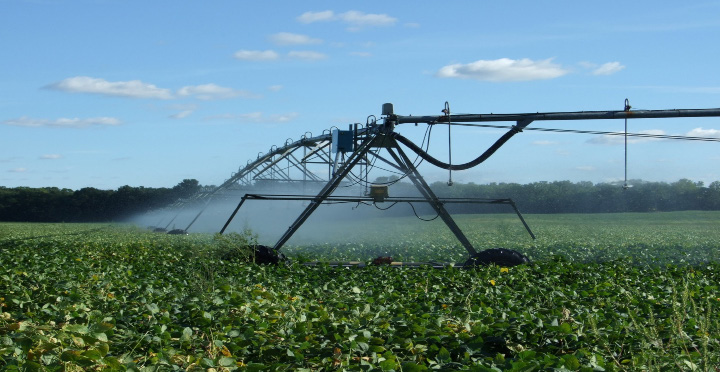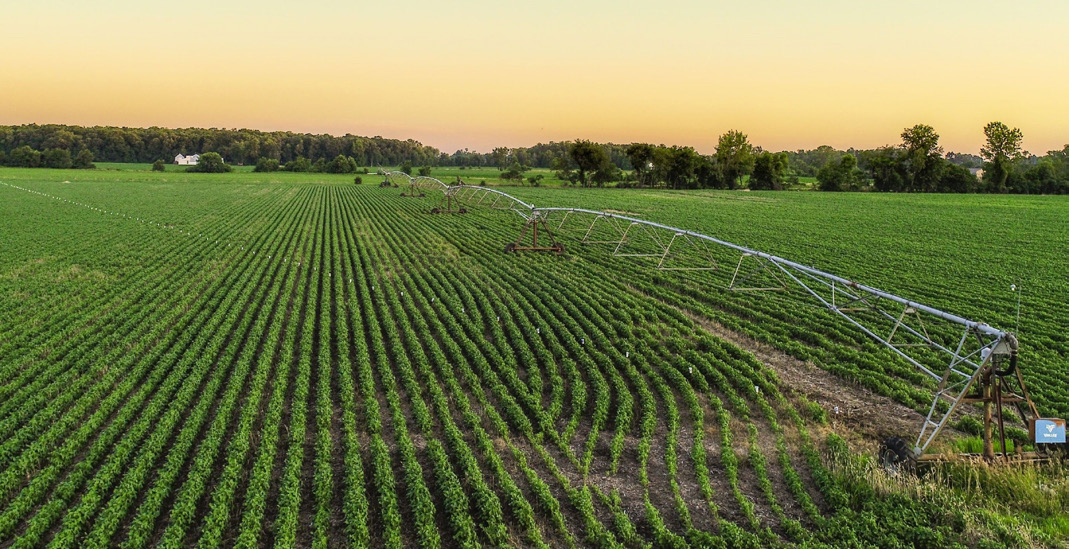
Improving Irrigation Efficiency & Annual Water Use Reporting
DOWNLOADMay 1, 2023 - Michigan State University Extension
Impacts
Agricultural irrigation accounted for 39% of Michigan’s consumptive water use in 2015 (Michigan Department of Environmental Quality, 2017), with 125 billion gallons of water withdrawn in 2020 (Eaton, 2021). Energy consumption of center pivot systems, which accounts for approximately 90% of Michigan’s irrigation (U.S. Department of Agriculture, 2018), is estimated at 4% of Michigan’s total energy consumption (U.S. Energy Information Administration, 2021). Since over 95% of the energy for irrigation is used for pumping water, energy efficiency is tied tightly to water use efficiency (Ciolkosz & Go, 2022). The two greatest factors affecting irrigation efficiency are irrigation system uniformity and proper scheduling of irrigation applications. Michigan State University Extension used a variety of methods such as in-person and recorded presentations, articles, websites and field demonstrations to educate irrigators and policymakers in 2022.
- 43 invited irrigation presentations were given.
- 2,283 farmers, agricultural professionals and policymakers participated.
- 72 work groups and farms were visited to support 588 producers and agricultural professionals.
Priority Areas
Irrigation plays an important role in Michigan agriculture, supporting various crops such as corn, soybean, potato, fruits, vegetables and orchards. High-value crops including potatoes, vegetables, fruits and seed crops are nearly 100% produced under irrigation and require an irrigation system upon contract. Only 7% of Michigan’s farmland is irrigated, but this irrigated land accounts for over 40% of the state’s cropland income (Michigan Farm Bureau, 2023).

For additional information regarding irrigation educational programs and materials, contact:
Lyndon Kelley, MSU Extension/Purdue Extension irrigation specialist, by phone at 269-467-5511 or by email at kelleyl@msu.edu.
Younsuk Dong, MSU Biosystems and Agricultural Engineering assistant professor and irrigation specialist, by phone at: 517-432-8751 or by email at dongyoun@msu.edu.
Irrigation Educational Presentations & Outreach
In 2022, staff from the MSU Department of Biosystems and Agricultural Engineering and MSU Extension developed and delivered 43 presentations focused on improving irrigation system uniformity and irrigation scheduling. These presentations were given at field days hosted by MSU Extension, commodity groups, other state agencies and irrigation equipment suppliers. More than 2,283 farmers, agricultural professionals and policymakers participated. The participating farmers irrigate various crops including field crops, vegetable crops, fruit crops and ornamentals. Younsuk Dong, MSU assistant professor and irrigation specialist, and Lyndon Kelley, MSU Extension and Purdue Extension irrigation specialist, published four articles on irrigation system uniformity and proper scheduling in farm papers, agriculture-focused magazines and newsletters. Two of the articles were published in Vegetable Grower News magazine, which has over 15,000 subscribers and more than 30,000 viewers. In 2022, the MSU Biosystems and Agricultural Engineering Irrigation website had website traffic of 585 visits, 964 pageviews, 800 unique pageviews and 99 downloads of Extension bulletins and irrigation scheduling tools. The number of visitors to the website increased by 20% compared to 2021. Average yearly website traffic to MSU Irrigation Extension over the past 3 years was 1,171 visits.
Catering to those producers and irrigation enthusiasts desiring a webinar and recorded irrigation information, MSU Extension and the MSU Department of Biosystems and Agricultural Engineering coordinated a Water Management Day during the last two winters. Younsuk Dong presented on several aspects of increasing irrigation efficiency. MSU irrigation and field crop educators also presented on other aspects of irrigation and crop production. The recorded presentations serve as a library of information on various water management topics that can be accessed throughout the year.
Using Field Demonstrations to Improve Irrigation Efficiency
Two field demonstrations documented improvements that could be made to typical irrigation systems with an upgrade of the sprinkler package. The coefficient for uniformity for one of the pivots was increased by 20%, resulting in a water savings of 1.2 inches per acre in a typical season. This is equivalent to 3.2 million gallons of water saved and more than $600 of energy savings for a 100-acre irrigated field. This information has been crucial in the planning process for two proposed irrigation efficiency educator positions.

MSU Biosystems and Agricultural Engineering’s grant project through the U.S. Department of Agriculture (USDA) Natural Resources Conservation Service (NRCS) Conservation Innovation Grants aims to demonstrate irrigation scheduling best management practices. The project looks at four irrigated fields in corn and soybean rotations along with a vegetable production site. The fields are divided into four quadrants allowing four different irrigation applications to be compared to the non-irrigated section of the field. The treatments being compared in this project are:
- Producer’s typical management
- Irrigation scheduling using Internet of Things–based (IoT-based) soil moisture sensor recommendation
- 130% of the irrigation scheduling using IoT-based soil moisture sensor recommendation
- 70% of the irrigation scheduling using IoT-based soil moisture sensor recommendation
- Non-irrigated section of the field
The USDA NRCS and Michigan Soybean Commission– supported irrigation demonstration study conducted by the MSU Irrigation Lab found that the IoT-based soil moisture sensor recommendation helped to save 1 inch of applied irrigation water in a commercial corn field and 2 inches of water application in a soybean field while maintaining the same yield as the farmer’s existing irrigation strategies (crop condition and soil feel testing). In 2018, irrigated corn and soybean acres in Michigan were 295,000 and 104,000 acres, respectively (USDA, 2018). Therefore, up to 13.6 billion gallons of freshwater, representing about 11% of Michigan’s total agricultural water use (125 billion gallons in 2020) from irrigated corn and soybean fields, could be conserved by using the IoT-based irrigation technology.
In addition, the MSU Irrigation Team received funding from the Michigan Potato Industry Commission, the Michigan Blueberry Commission, Project GREEEN (Generating Research and Extension to meet Economic and Environmental Needs), and MTRAC (Michigan Translational Research and Commercialization) Program by the State of Michigan 21st Century Jobs Fund received through the Michigan Strategic Fund and administered by the Michigan Economic Development Corporation, to demonstrate the IoT-based sensor-based irrigation recommendation in irrigated potato and blueberry fields.
Michiana Irrigated Corn & Soybean Conference
Producing corn and soybeans under irrigation provides both opportunities and challenges for producers. A high concentration of irrigated crop production occurs in southwest Michigan and northwest Indiana. Because of these factors, MSU Extension and Purdue University Extension have collaborated with the corn and soybean checkoff organizations in Michigan and Indiana to conduct a high-profile, multi-state educational program since 2014. Held virtually in 2021, the program returned to an in-person format in 2022. The program took place in Shipshewana, Indiana, on Feb. 16, hosting 93 participants ranging from producers to agronomists.
Of the 50 participants completing a post-meeting evaluation, 96% reported their knowledge of the subject matter addressed had increased, and 36 individuals indicated they intended to change some aspect of their farm or business as a result of the program. These intended changes are estimated to impact 28,935 acres resulting in an increase in revenue or savings of $296,958.
A follow-up evaluation to measure and document the actual educational and financial impacts of the program was mailed to the 93 meeting participants in December 2022. Responses revealed that 10 producers believed they earned additional money by implementing the new information they learned at the program. The average amount of additional income was $22.44 per acre applied to 6,429 acres, producing an actual financial impact of $144,242 in 2022 alone.

The participants also provided specific changes they made and listed corn and soybean topics they wanted to learn more about.
Producers raising corn and soybeans under irrigation in southwest Michigan and northwest Indiana have come to rely on this annual event as an important source of information for helping them mitigate the challenges and maximize the opportunities associated with irrigated crop production. This is demonstrated by the consistently strong attendance and the willingness of participants to provide meaningful input regarding topics for future meetings.
"We regularly attend this program, so I have picked up quite a bit of information over the years. The white mold information and how to manage beans under irrigation have been the most helpful. Lower populations, white mold tolerant soybeans, watering schedules, row widths, etc., have been the changes we recommend to customers." -Michiana Irrigated Corn and Soybean Conference participant
Educating & Assisting Producers About Michigan Large-Volume Water Use,
Policies & Regulations
A reliable and correctly sized water supply that meets the state’s registration and reporting requirements is a necessity for the long-term viability of any irrigation system. Meeting the regulatory requirements is important, but education on registration and reporting is not a large draw for agricultural producers to an educational event. Working small doses of education on Michigan’s registration and reporting system into all irrigation-related education meetings is a goal for MSU Extension irrigation educators.
MSU Extension educators provided awareness and education on the topic of large-volume water use registration and reporting requirements to over 1,200 Michigan producers as a part of 53 educational meetings during 2022. Training on Michigan’s online water use reporting system was often included. Michigan’s large-volume water use registration and reporting requirements education is targeted at areas of high large-volume water use and low compliance. The audience ranged from 2 to 120 producers in field crop, horticultural, livestock and dairy production.
Three news releases that included an overview of Michigan’s water registration and reporting process distributed information in Michigan. Sixty-five large-volume water users were trained or assisted in meeting the Michigan large-volume water use requirements through farm visits, small work groups and email contacts. Support was provided to 11 water policy workgroup sessions hosted by four large-volume user groups or agricultural commodity-based groups.
Over 50 producers received copies of irrigation fact sheet No. 11, Checklist for Irrigation Planning. The fact sheet discusses 14 points crucial to irrigation planning including water volume needs for the Michigan registration process and a reminder for reporting. This fact sheet is often used as an outline for farm visits or farm specific discussions with potential new irrigators and producers with new irrigation project challenges.
References
Ciolkosz, D., & Go, A., (2022). Energy use on the farm. In D. Ciolkosz (Ed.), Regional perspectives on farm energy. Springer. https://link.springer.com/chapter/10.1007/978-3-030-90831-7_1
Eaton, A., (2021). MAEAP water use reporting. (MDARD Annual Report 2021). https://www.michigan.gov/mdard/-/media/Project/Websites/mdard/documents/environment/maeap/2022-maeap-water-use-reporting-annual-report.pdf?rev=406aafec47c54de9b3d3fa7eea800e04&hash=4016F6CB2E918414C66C0AC69CDB4D35
Michigan Department of Environmental Quality. (2017). Water use statistics. https://www.michigan.gov/-/media/Project/Websites/egle/Documents/Multi-Division/Water-Use-Statistics.pdf?rev=4a29b80e499549c294bbdf0044b507fa
Michigan Farm Bureau. (2023). Act now to protect water use for food production. Farm News Media. https://www.michiganfarmnews.com/act-now-to-protect-water-use-for-food-production
U.S. Department of Agriculture. (2018). 2018 irrigation and water management survey. USDA National Statistics Service.
U.S .Energy Information Administration. (2021). Michigan Electricity Profile 2021. https://www.eia.gov/electricity/state/michigan/



 Print
Print Email
Email